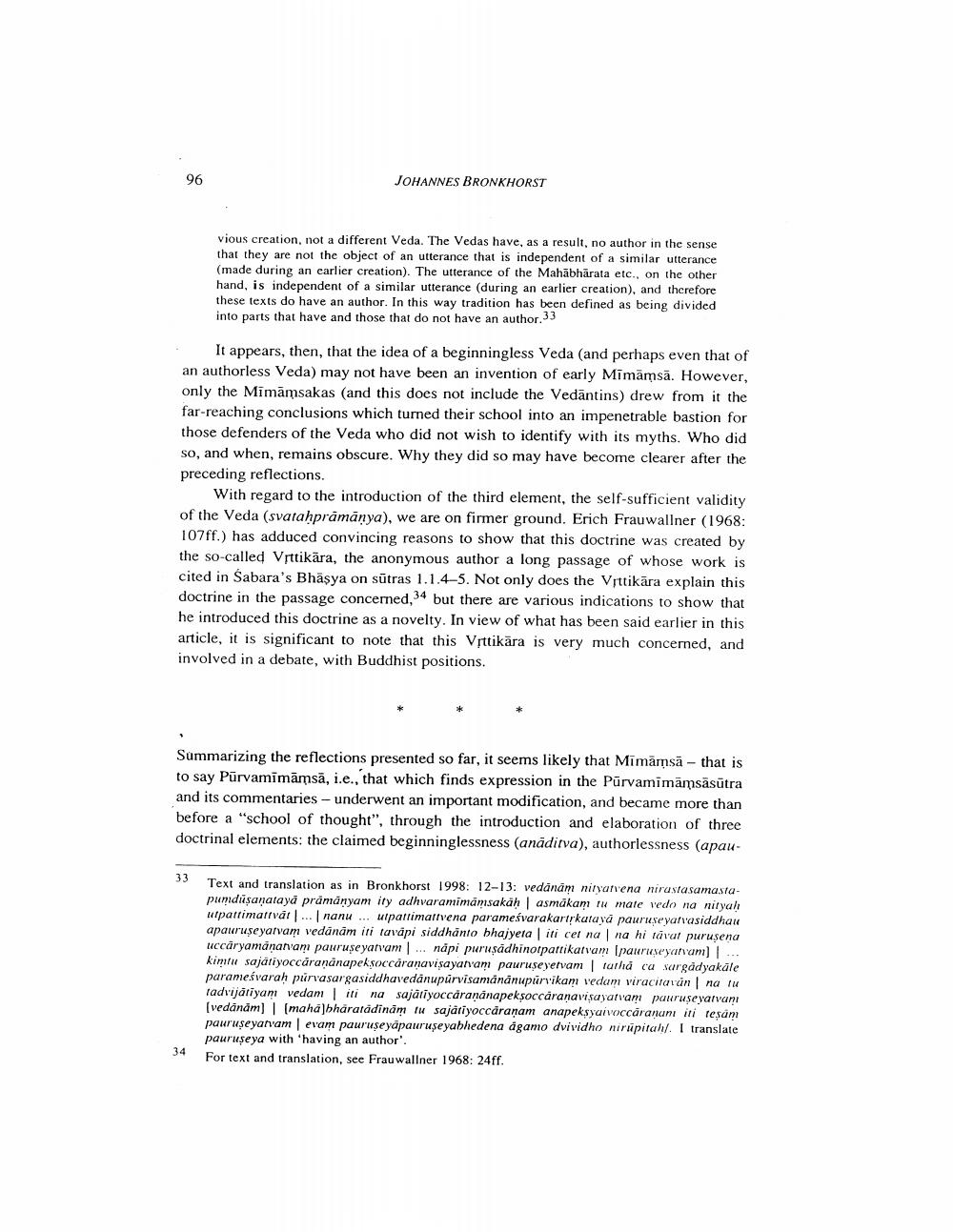________________
96
JOHANNES BRONKHORST
It appears, then, that the idea of a beginningless Veda (and perhaps even that of an authorless Veda) may not have been an invention of early Mīmāmsā. However, only the Mīmāmsakas (and this does not include the Vedantins) drew from it the far-reaching conclusions which turned their school into an impenetrable bastion for those defenders of the Veda who did not wish to identify with its myths. Who did so, and when, remains obscure. Why they did so may have become clearer after the preceding reflections.
vious creation, not a different Veda. The Vedas have, as a result, no author in the sense that they are not the object of an utterance that is independent of a similar utterance (made during an earlier creation). The utterance of the Mahabharata etc., on the other hand, is independent of a similar utterance (during an earlier creation), and therefore these texts do have an author. In this way tradition has been defined as being divided into parts that have and those that do not have an author.33
With regard to the introduction of the third element, the self-sufficient validity of the Veda (svataḥprāmāṇya), we are on firmer ground. Erich Frauwallner (1968: 107ff.) has adduced convincing reasons to show that this doctrine was created by the so-called Vṛttikära, the anonymous author a long passage of whose work is cited in Sabara's Bhasya on sūtras 1.1.4-5. Not only does the Vrttikara explain this doctrine in the passage concerned,34 but there are various indications to show that he introduced this doctrine as a novelty. In view of what has been said earlier in this article, it is significant to note that this Vṛttikara is very much concerned, and involved in a debate, with Buddhist positions.
33
34
Summarizing the reflections presented so far, it seems likely that Mīmāmsā - that is to say Pūrvamīmāmsā, i.e., that which finds expression in the Purvamimämsäsūtra and its commentaries - underwent an important modification, and became more than before a "school of thought", through the introduction and elaboration of three doctrinal elements: the claimed beginninglessness (anaditva), authorlessness (apau
Text and translation as in Bronkhorst 1998: 12-13: vedänam nityatvena nirastasamastapumdüṣaṇataya pramanyam ity adhvaramimämsakäḥ | asmākam tu mate vedo na nityaḥ utpattimattvät... | nanu.... utpattimattvena parameśvarakartṛkataya pauruşeyatvasiddhau apauruşeyatvam vedänām iti tavapi siddhanto bhajyeta | iti cet na | na hi tavat puruşena uccāryamāṇatvam pauruşeyatvam... näpi puruṣādhinotpattikatvam [pauruşeyatvam] | kimtu sajatiyoccaraṇanapekṣoccaraṇaviṣayatvam pauruşeyetvam | tatha ca sargadyakale parameśvaraḥ purvasargasiddhavedänupürvisamānānupurvikam vedam viracitavan | na tu tadvijātīyam vedam | iti na sajâtiyoccaraṇanapekṣoccaraṇaviṣayatvam pauruşeyatvam [vedänăm] | [mahabharatadinām tu sajatiyoccaraṇam anapeksyaivoccaranamı iti teşam pauruşeyatvam | evam pauruşeyāpauruşeyabhedena agamo dvividho nirupitahl. I translate pauruşeya with 'having an author'.
For text and translation, see Frau wallner 1968: 24ff.




